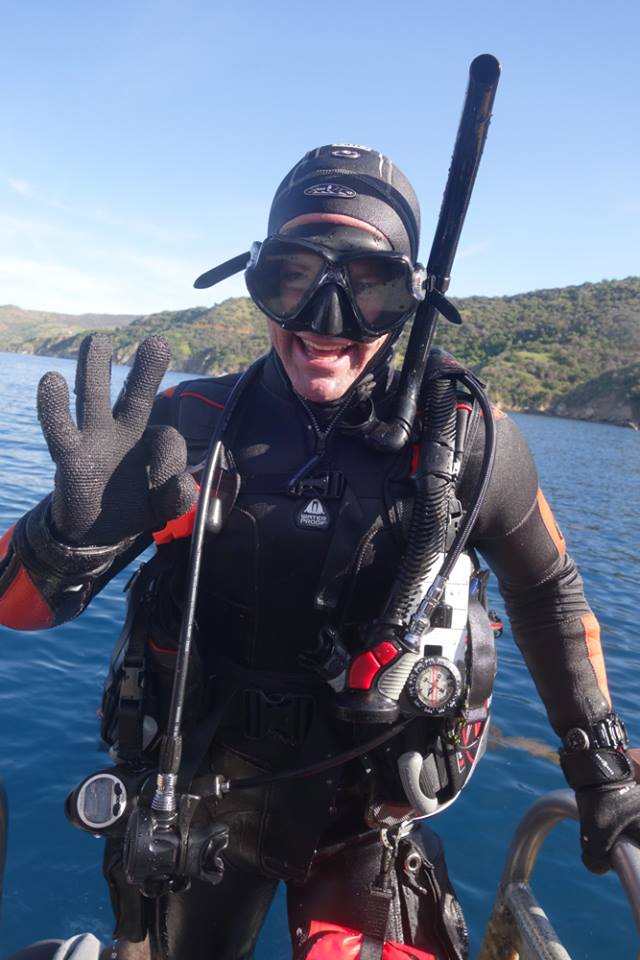San Miguel Island by Dan S.
The Northern Channel Islands are San Miguel, Santa Rosa, Santa Cruz and Anacapa. 20 million years ago the islands were off present day San Diego. The expanding Pacific plate has continued to push the Channel Islands northward. San Miguel Island lies off Point Conception and is a part of the faunal divide, separating Northern and Southern California ecology. Here, we are lucky to see the wildlife of both the northern colder waters and the warmer southern water. It is exactly for this reason conditions can be rough as the two regions converge. Here there are rockfish, wolf eels, lots of pinnipeds and even great whites. A real treat for us Southern California divers is to see the Sunflower Sea Star, which is the biggest starfish in the world and a cold water dweller. During one El Nino years we even saw scallop nosed hammerheads come all the way up from Mexico.
San Miguel sits the farthest west of the all the Channel Islands and is remote even for most divers, in fact Richardson Rock is the last bit of land until one reaches Hawaii. San Miguel is 14 square miles and is buffeted by strong winds and erosion. It is a wild windswept plateau surrounded by pinnacles. At one time the pleistocene pygmy mammoth made its home here and scientist still find their bones as erosion exposes their fossilized remains. Today the most famous inhabitants of the island are the Island foxes and if you are into birds San Miguel is also home to many sea birds.
Not only is the island remote but conditions can be harsh. The island sits exposed to the great pacific winds and waves. Divers face strong currents and cold upwelling, which bring nutrient rich water towards the surface. The water averages 10 degrees colder up here than the other islands, but all this cold water makes life abundant and diverse here. It is a very special place and if you made it out here then you already have been very fortunate. The average visitors to the island are less than 100 per year. As diving goes, because of its remote location and conditions many consider this an advanced diver spot. Consider the nearest hyperbaric chamber to be 100 miles at USC and the West End of Catalina at 108 miles. The first time I dove the spot my impression was that of diving in the “Wild West”.
The best time to dive San Miguel is in the fall, October and November is fantastic diving here. San Miguel’s dive spot are numerous, some of the big ones are Lover’s Cove, Castle Rock, Judith Rock,Wilson Rock and Wycott Ledge. These “rocks” are actually the tops of undersea mountain ridges. Judith Rock is a good spot for a deep dive, lots fish and nudibranchs, it is best to go down the anchor chain and circle the rock right to left around the top of the pinnacle, This spot is a no take area as it is labeled an MPA. Point Bennett is one of my favorites, it is a challenging dive with lots of structure and equally challenging surge. Best to stay conservative and near the boat, if you venture out farther be absolutely sure to have a SMB and some way to alert the boat, also it is best to stay in the less than 60 ft depth range around Point Bennett. If the boat gets closer to the beach you may have a chance to dive the “Oil Spring” this spot has lots of craggy structure and sand, it is close to a major seal haul out so watch out for pinnipeds” Web- Footed Mammals”. Prince Island is a shallow reef and another favorite of mine.The current really rips here in a northern direction here, so start your dive heading south, This is also a big time lobster spot and great for macro photography. This is the spot the I once saw two scallop nose hammerheads from the deck of our dive boat Truth during the El Nino year of 2015. Lastly, off of Castle Rock is a spot known as Shark Park, in very calm weather it can be dived, but when there is a big swell running it is also said to be the heaviest wave for big wave surfers in California. Diving the North side of Castle Rock is also very exciting, and here you will find a series of ridges that are abundant with life, the current can be running strong near the top of the ridges but you can easily find protection diving the base of the ridges and exploring their craggy structure.
Off of Point Bennett is also the wreck of the “Cuba”, launched in 1897 at Hamburg Germany she became a war prize when the US entered the first world war. She eventually was employed by the Pacific Mail Ship Company making runs from San Francisco to South America and Havana. On September 8th, 1923 at 0300 am off San Miguel Island the captain made a fateful navigational error in the fog that led to the ship’s demise on the rocks off Point Bennett. The captain and some of the crew remained aboard to protect the cargo and silver bullion on board while the passengers got off in lifeboats. On the same fateful day the fog took seven Navy destroyers off Point Honda.This was to become the Navy biggest peacetime loss of ships right off the California coast. During World War II the Navy took San Miguel for practicing bombing runs and naval bombardment. From then until the 1970’s the navy shelled the island, then beginning in 2014 the Navy spent two years clearing the island and in 2016 the Navy turned the island’s management over to the National Park Service while still retaining ownership to this day.
I have been very very fortunate to have dove the island and will always consider it a blessing. No matter what the conditions are like there is something in store for the divers with a thirst for adventure. On days when the water was a green as a golf course I have seen amazing blue whales feeding on plankton, on days when visibility was 80 feet I have hung on the anchor chains to sit and marvel at the passing salps and their beautiful display of luminescence.
Just come ready for adventure and a sense of wonderment at what the islands have to offer.
What to look for:
Lingcod, Rock Fish, Lobster, Anemones, Scallops, Metridium Anemones, Nudibranchs, Green Abalone, Red Snapper, Sheephead, Horn Sharks, Octopus. HINT; this works for me I pick a fish to find then never find that fish but see so much more looking for my specific fish.
Also from about June until October you can see Blue Whales in the Channel, during these months krill is most abundant. Hump Back whales can been seen from May to September, although I Have seen them in mid October as well. These whales are easily spotted by their acrobatic behavior and their relatively slow swimming speed.
Plankton Blooms usually occur in the Springtime, during this time is when we see Gray Whales on their ceaseless 10,000 mile migration. This is the longest migration for any animal. They generally leave Alaska in October and pass through the Channel in December and January then again in February and March. Plankton blooms are what spawns all of this as zooplankton eats the phytoplankton and in turn zooplankton are eaten by fish thus the complex food chains begins in the Channel Islands.
GO BACK TO DIVER PROFILE






























